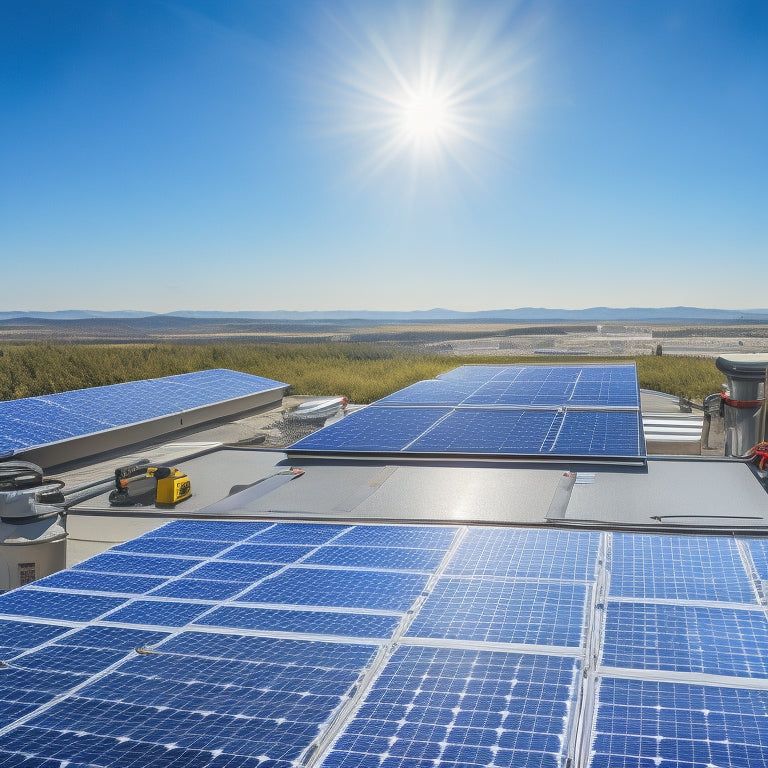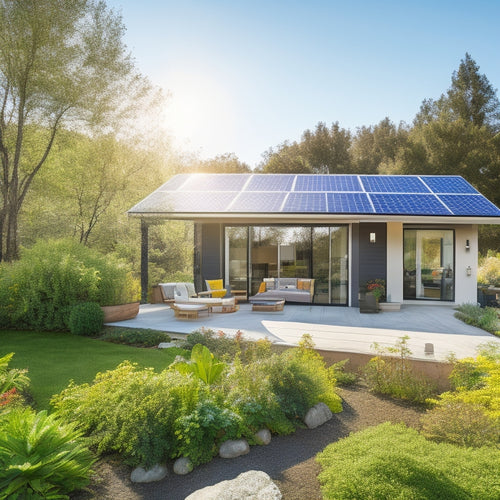
3 Tips to Reduce Commercial Solar Panel Maintenance Costs
Share
To reduce commercial solar panel maintenance costs, you can start by optimizing your cleaning and inspection schedules to minimize downtime and performance degradation. Implement proactive monitoring strategies, using real-time issue detection and predictive analytics to identify potential issues before they become major problems. Additionally, streamline your inverter replacement processes by maintaining a spare inventory, forecasting failures, and training personnel on replacement procedures. By adopting these strategic practices, you can minimize maintenance costs and maximize energy production - and there's more to explore on how to optimize your solar panel maintenance.
Key Takeaways
• Streamline cleaning and inspection schedules to reduce downtime and performance degradation, ensuring optimal energy output.
• Implement proactive monitoring strategies to detect issues promptly, minimizing maintenance costs and energy losses.
• Maintain a spare inverter inventory and develop predictive maintenance schedules to reduce downtime and replacement costs.
• Optimize maintenance practices to maximize energy production, minimizing costs and ensuring peak performance.
• Train maintenance personnel on efficient inverter replacement procedures to reduce downtime and costs.
Optimize Cleaning and Inspection Schedules
By streamlining your cleaning and inspection schedules, you can reduce downtime and minimize the likelihood of performance degradation, thereby saving on maintenance costs. Effective schedule optimization involves analyzing your solar panel system's specific needs and adjusting your cleaning and inspection frequencies accordingly.
This can be achieved through frequency analysis, which helps identify the best cleaning and inspection intervals to guarantee maximum energy output.
Implement Proactive Monitoring Strategies
To guarantee your commercial solar panel system operates at peak performance, you should implement proactive monitoring strategies that enable real-time issue detection and swift response to potential problems. By doing so, you'll minimize downtime, reduce maintenance costs, and maximize energy production.
Implementing a monitoring system that leverages predictive analytics will help identify potential issues before they occur. This enables you to schedule maintenance during periods of low energy demand, reducing the impact on your operations.
You'll receive real-time notifications when issues arise, allowing you to respond swiftly and prevent minor issues from becoming major problems. Additionally, proactive monitoring enables you to track performance metrics, identify trends, and optimize system operation.
Streamline Inverter Replacement Processes
Replacing inverters promptly and efficiently is essential to minimize system downtime and maintain peak energy production. It's important to develop a streamlined process for inverter replacement that includes identifying potential inverter failures through failure forecasting and implementing inverter redundancy to guarantee seamless energy production.
Here are three key strategies to streamline your inverter replacement process:
-
Implement a spare inverter inventory: Having spare inverters on hand can greatly reduce downtime and allow for swift replacement, minimizing energy production losses.
-
Develop a predictive maintenance schedule: Regularly inspecting and testing inverters can help identify potential issues before they cause system downtime, allowing for proactive replacement and minimizing energy losses.
-
Train personnel on inverter replacement procedures: Ensuring that your maintenance team is well-versed in inverter replacement procedures can decrease replacement time and minimize errors, resulting in faster system recovery and reduced energy losses.
Frequently Asked Questions
Can Solar Panels Be Cleaned During Extreme Weather Conditions?
When you're wondering if solar panels can be cleaned during extreme weather conditions, remember that weather resistance is key; stick to your regular cleaning schedules, but avoid cleaning during heavy rain, strong winds, or intense sunlight to prevent damage.
How Often Should I Inspect My Commercial Solar Panel System?
Coincidentally, your solar panel system's efficiency mirrors your diligence in inspecting it. You should perform system checks every 3-6 months, with more frequent inspection intervals during extreme weather conditions, to guarantee maximum energy harvest and identify potential issues early.
Are There Any Incentives for Maintaining Commercial Solar Panels?
You can claim tax credits and government rebates for maintaining your commercial solar panels, which can help offset maintenance costs; in fact, the Solar Investment Tax Credit (ITC) allows you to deduct 26% of eligible expenses.
What Is the Average Lifespan of a Commercial Solar Panel Inverter?
You're about to be shocked: commercial solar panel inverters can last a whopping 50 years or more, but let's get real - lifespan factors like temperature, humidity, and quality affect inverter reliability, typically averaging 15-20 years.
Can I Perform Maintenance Tasks on My Own or Do I Need Professionals?
You can leverage your DIY capabilities for basic maintenance, but complex tasks require expert consultation to guarantee peak performance and avoid voiding warranties, so assess your skills and know when to seek professional help.
Related Posts
-

Solar Power Savings for Environmentally Aware Consumers
Switching to solar power lets you drastically cut your carbon footprint while saving money in the long run. Each kilo...
-

Green Home Improvements Using Solar Power
Investing in solar power alters your home into a sustainable haven while slashing energy costs. You can greatly reduc...
-

Innovative Sustainable Materials for Energy-Efficient Homes
Innovative sustainable materials enable you to create energy-efficient homes while promoting environmental responsibi...


